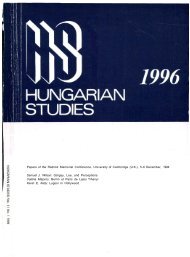The Canadian-American Review of Hungarian Studies - Vol. 4 ... - EPA
The Canadian-American Review of Hungarian Studies - Vol. 4 ... - EPA
The Canadian-American Review of Hungarian Studies - Vol. 4 ... - EPA
You also want an ePaper? Increase the reach of your titles
YUMPU automatically turns print PDFs into web optimized ePapers that Google loves.
speaking poets, including such important poets as W. H. Auden,Robert Graves, Michael Hamburger, Ted Hughes, Edwin Morgan andJohn Wain. Internationally recognized scholars <strong>of</strong> <strong>Hungarian</strong> letters,such as George Gomori, George Cushing, and Watson Kirkconnell,have also contributed translations. And some selections come from<strong>Hungarian</strong>s such as Paul Tabori who have themselves become writers inEngland and America. Because <strong>of</strong> the range <strong>of</strong> translators, a distinctvoice in English is assured for each <strong>Hungarian</strong> poet.<strong>The</strong> historical scope <strong>of</strong> Kabdebo's anthology is ambitious. He includespoets from the Renaissance and Reformation to the present,arranging the one-hundred poems chronologically according to thebirth <strong>of</strong> the author. However, the emphasis <strong>of</strong> Hundred <strong>Hungarian</strong>Poems is on more recent poets; more than half the anthology is devotedto the twentieth century. Firmly established modern writers such asAdy, G. Juhasz, Babits, Kassak, Illyes, Attila Jozsef, and Radnoti are <strong>of</strong>course included. Also, a surprisingly comprehensive selection <strong>of</strong> contemporarypoetry is given. A number <strong>of</strong> the important poets living inHungary today are represented F. Juhasz, L. Nagy, Weores, andPilinszky all have a poem or two. Kabdebo also includes not-so-<strong>of</strong>tenread <strong>Hungarian</strong> poets living outside the national boundaries <strong>of</strong> Hungary,thereby expanding the anthology's range. Among these poets areF. Feher (Jugoslavia), G. Paskandi (Romania), G. Gomori and Cs.Szabo (England), L. Kemenes Gefin, G. Faludy and F. Fay (Canada),and A. Makkai (USA).<strong>The</strong> anthology is not without problems. Using the <strong>Hungarian</strong> tricolorsred, white and green across the entire cover is an eye-catchingidea. Unfortunately, the horizontal colors are inverted, appearinggreen, white and red — the color arrangement <strong>of</strong> the flag <strong>of</strong> Iran. A fewtypographical errors occur. It is not so bad that Jozsef Erdely's Christianname appears with a "d" rather than an "f" in the biographicalsection "Notes on the Poets" (p. 1 12). When it is obvious to the readerthat a name is misspelled, the error is not so important. But when atypographical error occurs in a line <strong>of</strong> poetry, as in Gyorgy Ronay's"<strong>The</strong> Death <strong>of</strong> Virginia Woolf," it is not so easy to make allowance. Inthe line "<strong>The</strong> weaves are splashing round my hips," "waves" shouldreplace "weaves" (p. 84). This is disconcerting because "weaves" is anoun that fits into the grammatical logic <strong>of</strong> the line. Without a closereading, a reader could take this line for a clumsy image, which it is not.Hundred <strong>Hungarian</strong> Poems could have a more convenient format aswell. Since it is designed for the English-speaking reader, it would havebeen appropriate to follow organizational conventions usually found in
















